Europe, British Isles, North-Central England, Derbyshire Dales, Chatsworth House [Map]
Chatsworth House is in Chatsworth [Map].
Chatsworth House [Map].
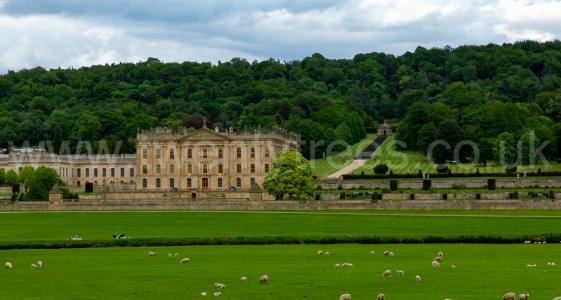
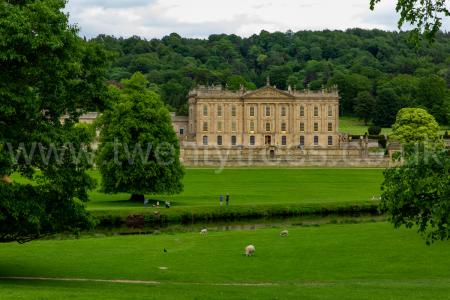
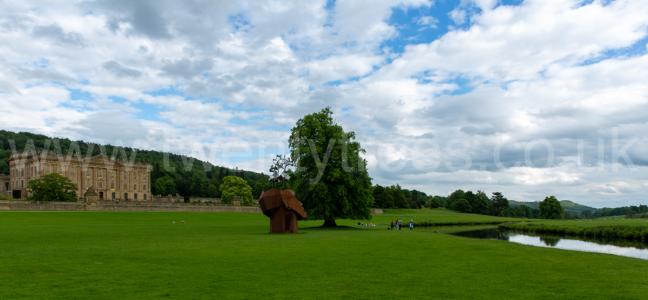
In 1549 the Leche family sold Chatsworth House [Map] to William Cavendish (age 44). His wife Bess of Hardwick (age 22) had persuraded him to sell his ancestral lands around Cavendish, Suffolk [Map] and buy land around her ancestral lands.
In 1553 William Cavendish (age 48) and Bess of Hardwick (age 26) commissioned the building of a new house [Chatsworth House [Map]]. She selected a site near the river, which was drained by digging a series of reservoirs, which doubled as fish ponds.
On 31 Mar 1555 Elizabeth Cavendish Countess Lennox was born to William Cavendish (age 50) and Bess of Hardwick (age 28) at Chatsworth House [Map].
In the 1560s Chatsworth House [Map] was completed following the death of William Cavendish.
Archaeologia Volume 32 Section X. But her health gave way, and by the mediation of the French Ambassador she was permitted to visit the baths at Buxton [Map], during several summers. But, when there, all other persons were ordered to depart. Her first visit was in August, 1573, and before she returned to the castle she was allowed to visit Chatsworth [Map]. Her next visit to Buxton [Map] was in May and June, 1577. In the summer of 1578, she was again at Chatsworth [Map], and the visit was repeated in the summer of 1579, when she was also at Buxton [Map]. In 1580, the earl (age 45) applied for leave to visit Chatsworth [Map] with his charge, and was refused; but in the July of that year the Queen (age 30) was at Buxton [Map]. Again, in July, 1581, we find her at Chatsworth [Map]; in June, 1582, at Buxton [Map], where also she appears to have been in July, 1584.

In Oct 1577 Walter Mildmay (age 56) and William Cecil 1st Baron Burghley (age 57) visited Mary Queen of Scots (age 34) at Chatsworth House [Map] after she had announced that she had important secrets to reveal to Elizabeth.


On 13 Feb 1608 Bess of Hardwick (age 81) died. She was buried in All Saints Church, Derby [Map]. Her monument, which she had constructed before her death, was designed by Robert Smythson (age 38). She left nothing in her will for her 'bad son' Henry Cavendish (age 57). He did, however, inherit Chatsworth House [Map] which he subsequently sold in 1609 to his brother William Cavendish 1st Earl Devonshire (age 55) for £10,000.
The date of her funeral somewhat complicated. Rawsons 1910 book "Bess of Hardwick and her Circle" quotes Simpson's National Records of Derby for 1608: "The old Countess of Shrewsbury died about Candlemas this year, whose funeral was about Holy Thursday. A great frost this year. The witches of Bakewell hanged." Holy Thursday, the Feast of the Ascension, is thirty-nine days after Easter. Easter in 1608 was on the 6th of April, putting Holy Thursday on the 15th of May.
Ethel Carleton Williams "Bess of Hardwick", 1959, has a note: "9. The date of Bess of Hardwick's funeral is uncertain. The date on the coffin plate is said to be February 1608 (Cox and Hope, Chronicles of the Collegiate Church of All Saints, Derby), but on 31 March 1608 Gilbert Talbot wrote to Robert Cecil, excusing himself for not attending St George's Feast on the ground that his mother-in-law's funeral was to be on St George's Day (23 April). Later, on 3rd of April, the Earl of Arundel wrote to Gilbert (his father-in-law), 'the funeral at Derby is appointed to be either on the fourth or fifth of May, which Garter yet knoweth not, but rather thinketh on the fourth because the other is a holy day'".
Neither of which provide a definite answer. The former being around the 15th of May, the latter 'rather thinketh' the 4th of May. Are there any other contemporary sources available?
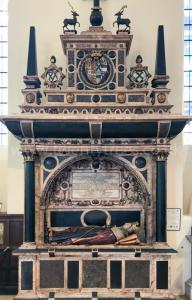
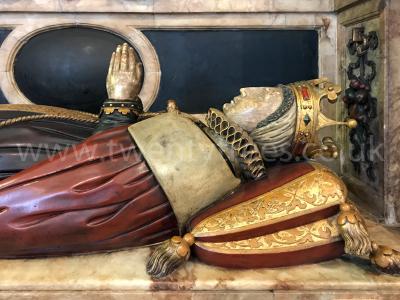
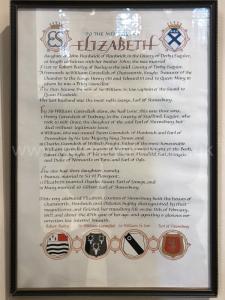
In 1687 William Cavendish 1st Duke Devonshire (age 46) commissioned the re-building of Chatsworth House [Map]. He initially planned to reconstruct only the south wing with the State Apartments, and so he decided to retain the Elizabethan courtyard plan, though this layout was becoming increasingly unfashionable. He enjoyed building and reconstructed the East Front, which included the Painted Hall and Long Gallery, followed by the West Front from 1699 to 1702. The North Front was completed in 1707 just before he died.
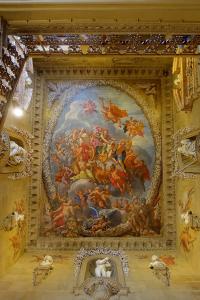 Around 1691 Antonio Verrio (age 55). The Great Staircase at Chatsworth House [Map].
Around 1691 Antonio Verrio (age 55). The Great Staircase at Chatsworth House [Map].
On 08 May 1777 Catherine Hoskyns Duchess Devonshire (age 78) died at Chatsworth House [Map].
Around 1785 Edensor, Chatsworth William Cavendish 6th Duke Devonshire, working with Joseph Paxton relocated Edensor, Chatsworth, possibly so that it could no longer be seen from Chatsworth House [Map]. One the east of the original village one house was left in situ being occupied by an elderly retainer Anthony Holmes. It was walled around to protect it against deer and cattle. Six houses were left in-situ although they were modified to include ornamental chimneys. The new village was provided with allotments, a small prison and a mortuary.
Greville Memoirs. Chatsworth [Map], September 27th, 1830.
Got to Sprotborough last Sunday; Lord Talbot and Lady Cecil, William Lascelles, Irby, Lady Charlotte Denison, Captain Grey. It rained all the time of the races. They offered Priam to Chesterfield for £3,000 before his match, and he refused; he offered it after, and they refused. There were a number of beautiful women there—my cousin Mrs. Foljambe, Misses Mary and Fanny Brandling the best. Came here on Friday night, and found as usual a large party, but rather dull; Granvilles, Newboroughs, Wharncliffes, G. Seymours, Sir J. and Lady Fitzgerald (very pretty), Talbots, Madame Bathiany, Beaumonts, G. Lamb. Yesterday Brougham came with his brother, sister, and daughter-in-law, in the highest spirits and state of excitement, going about Yorkshire, dining and speechifying; he was at Doncaster too. Lord Granville was just returned from Huskisson's (deceased) funeral at Liverpool. It was attended by a great multitude, who showed every mark of respect and feeling. He died the death of a great man, suffering torments, but always resigned, calm, and collected; took the Sacrament, and made a codicil to his will, said the country had had the best of him, and that he could not have been useful for many more years, hoped he had never committed any political sins that might not be easily forgiven, and declared that he died without a feeling of ill-will and in charity with all men. As he lay there he heard the guns announcing the Duke of Wellington's arrival at Manchester, and he said, 'I hope to God the Duke may get safe through the day.' When he had done and said all he desired, he begged they would open a vein and release him from his pain. From the beginning he only wished to die quickly. Mrs. Huskisson was violently opposed to his being buried at Liverpool, and it was with great difficulty she was persuaded to consent to the repeated applications that were made to her for that purpose.
In 1932 Charles Arthur Francis Cavendish (age 26) and Adele Astaire were married at Chatsworth House [Map]. He the son of Victor Christian William Cavendish 9th Duke Devonshire (age 63) and Evelyn Emily Mary Petty-Fitzmaurice Duchess Devonshire (age 61).
On 06 May 1938 Victor Christian William Cavendish 9th Duke Devonshire (age 69) died at Chatsworth House [Map]. He was buried at Cavendish Plot, St Peter's Church, Edensor [Map]. His son Edward William Spencer Cavendish 10th Duke Devonshire (age 43) succeeded 10th Duke Devonshire, 13th Earl Devonshire, 5th Earl Burlington. Mary Alice Gascoyne-Cecil Duchess Devonshire (age 42) by marriage Duchess Devonshire. On 02 Apr 1960 Evelyn Emily Mary Petty-Fitzmaurice Duchess Devonshire (age 89) died. Both the Duke and Duchess were buried in the Cavendish Plot, St Peter's Church, Edensor [Map].

Evelyn Emily Mary Petty-Fitzmaurice Duchess Devonshire: On 27 Aug 1870 she was born to Henry Petty-Fitzmaurice 5th Marquess Lansdowne. On 30 Jul 1892 Victor Christian William Cavendish 9th Duke Devonshire and she were married. She by marriage Duchess Devonshire. She the daughter of Henry Petty-Fitzmaurice 5th Marquess Lansdowne.
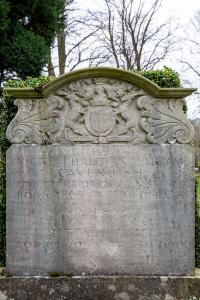
03 Jul 1942. Two German bombers returning from an unsuccessful trip to bomb Bolton dropped their bombs along the Sett Valley. Three stone cottages on Spring Vale Road [Map] were destroyed by German bombers. There were six fatalities: Albert and Edith Gibson, their two daughters Gladys and Margaret, together with Hannah Robinson, and Freda Thorpe, a ten-year-old evacuee from Manchester. Freda's two brothers and grandmother survived. Leaving Hayfield devastated, the planes climbed over Kinder Scout, veered to the south-east and re-established their heading towards Holland. As they passed Stoney Middleton, they dropped the last of their bombs at Darlton Quarry before strafing Chatsworth House [Map] as they made good their escape. At Chatsworth House the roof, north and west side of the house were hit by machine-gun bullets.
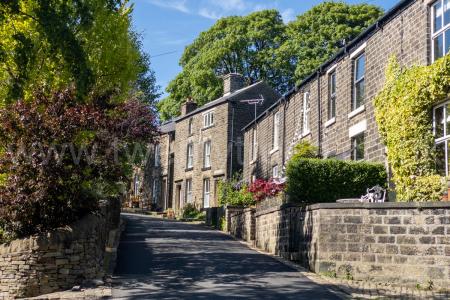
On 27 Apr 1944 Peregrine Cavendish 12th Duke of Devonshire was born to Andrew Cavendish 11th Duke Devonshire (age 24) and Deborah Vivien Mitford Duchess Devonshire (age 24) at Chatsworth House [Map]. He was educated at Eton College, Exeter College, Oxford, where he read history, and at the Royal Agricultural College (now the Royal Agricultural University), Cirencester.
Diary of Caroline Girlie. After having spent our time most agreeably with our Derbyshire, as we had before done with our Yorkshire friends, our London party set out on our return to the Metropolis, but in our way back was to stay a few days at Matlock [Map] and see Chatsworth [Map]; the latter we did the morning we left Mr. Slater's, it being about ten miles distant. This celebrated seat in the Peak of Derbyshire of his Grace of Devonshire I must own does not quite answer what report had taught me to expect, tho' undoubtedly striking; but I was told it would appear less so to us than to strangers in general by the Slaters having a key to go through his Grace's grounds, a better and much shorter road than the public one, but that did not give one near so picturesque a view of Chatsworth's [Map] situation as if we had gone down to it all at once from the barren moors. The house is of stone, and the architecture thought very fine, twenty-two rooms on a floor; the windows of the principal storey, seventeen feet in height, are all looking-glass, of panes two feet wide, the frames double gilt; the door, and window-frames, and staircases of marble; ceilings and some apartments painted by Verrio and other celebrated artists; there is some fine tapestry, and in one chamber a most elegant bed, and furniture of fine old print set upon Nankeen, which has a very pretty effect, as the colour of the ground sets off the work. There are many fine pictures; one range of rooms they still style Mary, Queen of Scots, as she was some time here, as well as at his Grace's other seat of Hardwick; there is a very elegant chapel, the altar and font fine marble, seats and gallery cedar, the walls and ceiling painted. The front towards the garden is esteemed a most regular piece of architecture. The frieze under the cornice has the family motto upon it, in gilt letters so large as to take up the whole length, tho' only two words, "Cavendo Tutos," which are as applicable to the situation of the house as the name of the family. The waterworks, which are reckoned the finest in England, were all played off, may be said to be more grand than pleasing, as there is a formality in them, particularly the grand cascade, which takes off every idea of the rural scene they are supposed to afford one, and a kind of triflingness (if I may make a word), in the copper1 willow-tree, and other contrivances beneath the dignity of the place. The gardens are fine. The very disadvantages of the situation contriving to their beauty. On the east side, not far distant, rises a prodigious mountain, so thick planted with beautiful trees that you only see a wood gradually ascending, as if the trees crowded one above the other to admire the stately pile before them. 'Tis said that Marshal Tallard when he returned to his own country, when he reckoned up the days of his captivity, said he should always leave out those he spent at Chatsworth; and I must own this magnificent (tho' at the same time gloomy), place may justly be stiled one of the wonders of the Peake.... In speaking of the waterworks, I forgot to mention the length of the great cascade, 220 yards long with twenty-three falls. In prosecuting our journey of about eleven miles, 'tis hardly possible to describe the variety of beauties; sometimes we were like Don Quixote, almost imagining ourselves enchanted, at another terrified by the huge rocks, which by their stupendous height seemed to threaten every minute to crush us by their fall. In the greatest of our terrors (when in a very narrow road, the above-mention'd rocks on one side, and an immense precipice down to the river on the other), we could not help laughing at the calm answer of one of the postillions, who by often going, I suppose, had not an idea of the danger we apprehended, for only calling out to beg he'd let us walk, and saying, "Where, friend, are you going?" "Only to Matlock Baths [Map], ladies." So indeed we knew, but at that moment doubted the wisdom of our driver, who, however conveyed us very safe to the destined spot. Ceremony seems banished from this agreeable place,. as on entering the long room strangers as well as acquaintances most politely made inquiries about the terrors of the way, &c, which themselves had before experienced. The very early hour of rising at Matlock [Map], gave us the next morning a still finer idea of the uncommon beauties of the place, as a most glorious day gave it additional lustre. The time of bathing is between six and seven, the water warm, and the pleasantest to drink that can be; at eight the company meet in the long room to breakfast in parties. This room and baths were built in 1734 by Stephen Egglinton. 'Tis a very good one, fifty feet long, windows all the way on each side, commanded the most romantic views, one way a fine terrace, beyond that a lawn extended to the river Derwent, which latter is a continual pleasing murmur by the current forcing itself over large pieces of rock; over this rises a most picturesque and natural shrubbery, to an immense and perpendicular height on the crag of rocks. On the left is seen Matlock High Torr [Map], a rocky mountain which, from the surface of the water 1757 to the top, is 445 feet. As there is always a cool spot among the woods, walking seems the particular amusement of the place. At two the bell rings for dinner, and, as before said, ease without unnecessary ceremony reigns here. Every one sits down without any form, those who come first by the rule taking the uppermost seats at the long table. There is a gallery for a band of music, who play the whole time of meals, The fatigue of dress, too, is at this public place quite avoided, as hats are general, as the company walk again till evening, when there is a ball in the long room till supper, and sometimes after. Every one retires very early, as few card-tables are seen, gaming not having yet reached this rural spot. The Boat-house, as 'tis call'd, we went one afternoon to drink tea at, where we bought curiosities of spars, &c, of the miners, men employed to the number of above ten thousand about Matlock [Map] only. We went, too, one morning to see them melt lead at a village near, call'd Cumford, but the heat was so intense we did not stay long among them; and the poor souls told us was often very prejudicial to them. That evening we went in a barge on the river, but it being not navigable, 'tis but in few places the stones and craginess of the rocks will allow of boats. Every evening almost we found new company on our return to supper. Tho' the numbers perhaps were lessn'd, as most likely as many were gone off the same morning, about a hundred generally assembled at dinner. I heard Miss Slater, who sometimes makes a stay there, say that two or three days has made a total change of inhabitants. We tried one evening to ascend the prodigious rock I before spoke of, call'd Matlock High Torr [Map]. Many do, it seems, perform it, but I own I was frighted before I had got a quarter of the way up, and each object below began to appear so diminutive that I, even with some others, consented to be ridiculed for my fears, and with vast joy got down again as soon as possible, and even thought I felt giddy for hours after, and thought myself most happy when I got into the grove, one of the sweetest walks in Matlock [Map].
Note 1. On pulling a string this sham tree deluges the stranger with a shower-bath.
Memorials of Francis Chantrey RA in Hallamshire and Elsewhere Part IV The in Sheffield. Ridiculous as it would be to look for the germ of his genius in any of those fictions of boyhood which I have previously mentioned, it does not seem equally immaterial here to remark, that at the time when Ramsay's apprentice first began to try his hand at modelling, there was not perhaps a large town in England that afforded fewer examples or incentives to such a pursuit than Sheffield. Three recumbent figures, and one kneeling effigy, in the "Shrewsbury Chapel," at the Parish Church [Map], comprised the monumental statuary-probably the work of Italian artists; while out-of-doors there were a respectably executed figure of Justice, by Waterworth, of Doncaster, at the head of the Shambles; a spirited profile of Shakspeare, with some dramatic symbols, on the pediment of the Theatre, executed by a wandering stranger of the name of Renilowe; a poor exhibition of the "Norfolk Arms" on the old Hospital Chapel, the joint work of one of the masons-Peter Skinner, of Gleadless and a rambling genius called "Jem Officer," from York; a small lugubrious lion over the door of the Assay Office, by H. Mozley, once an employé of Ramsay's; and, best of all, an "Angel, "in terra-cotta, with a brazen trumpet, as a sign on the inn and in the street denominated there from - the early work of Rossi, who, while a youth, lived with his father in a house opposite. Of course our young aspirant saw what works of the chisel were to be seen at Wentworth House - the present noble gallery at Chatsworth [Map] did not then exist: indeed, with the writer in the Atlas, I "happen to know that the few collections of ancient sculpture which were within his reach while he lived in the country were visited by him, and that in particular he paid two visits to Newby, whilst still a young man and still younger artist, and came away deeply impressed by the works of sculpture in that mansion." Perhaps it should be added, as somewhat remarkable, that, with the exception of the figures of the Marquis of Rockingham at Wentworth, and the Earl of Strafford at Stainbro', there did not at the period of Chantrey's apprenticeship - nor am I aware that there does at this day -- exist a single standing life-size statue, of modern man or woman, in marble or gritstone, within doors or without, either in Sheffield or within the circuit of more than a hundred miles around the town.
The River Derwent rises on Bleaklow [Map] after which it passes Bamford [Map], Hope, Derbyshire [Map], Hathersage [Map], Grindleford [Map], Baslow, Derbyshire [Map], Chatsworth House [Map] passing under Chatsworth Bridge [Map], Rowsley [Map] which it is joined by the Derbyshire River Wye, Matlock [Map], Matlock Bath [Map], Cromford [Map], Ambergate [Map] where it is joined by the River Amber. After Ambergate [Map] it passes Belper, Derbyshire [Map], Duffield, Derbyshire [Map] then flows through the centre of Derby [Map] after which it joins the River Trent around 1.4 Km east of [Map].